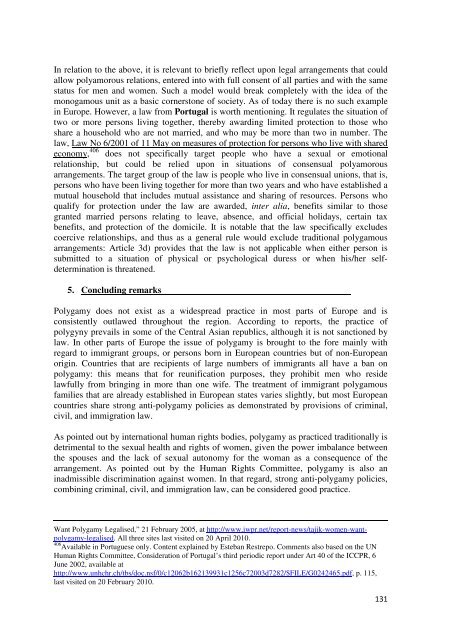Johanna Westeson - The ICHRP
Johanna Westeson - The ICHRP
Johanna Westeson - The ICHRP
You also want an ePaper? Increase the reach of your titles
YUMPU automatically turns print PDFs into web optimized ePapers that Google loves.
In relation to the above, it is relevant to briefly reflect upon legal arrangements that could<br />
allow polyamorous relations, entered into with full consent of all parties and with the same<br />
status for men and women. Such a model would break completely with the idea of the<br />
monogamous unit as a basic cornerstone of society. As of today there is no such example<br />
in Europe. However, a law from Portugal is worth mentioning. It regulates the situation of<br />
two or more persons living together, thereby awarding limited protection to those who<br />
share a household who are not married, and who may be more than two in number. <strong>The</strong><br />
law, Law No 6/2001 of 11 May on measures of protection for persons who live with shared<br />
economy, 406 does not specifically target people who have a sexual or emotional<br />
relationship, but could be relied upon in situations of consensual polyamorous<br />
arrangements. <strong>The</strong> target group of the law is people who live in consensual unions, that is,<br />
persons who have been living together for more than two years and who have established a<br />
mutual household that includes mutual assistance and sharing of resources. Persons who<br />
qualify for protection under the law are awarded, inter alia, benefits similar to those<br />
granted married persons relating to leave, absence, and official holidays, certain tax<br />
benefits, and protection of the domicile. It is notable that the law specifically excludes<br />
coercive relationships, and thus as a general rule would exclude traditional polygamous<br />
arrangements: Article 3d) provides that the law is not applicable when either person is<br />
submitted to a situation of physical or psychological duress or when his/her selfdetermination<br />
is threatened.<br />
5. Concluding remarks<br />
Polygamy does not exist as a widespread practice in most parts of Europe and is<br />
consistently outlawed throughout the region. According to reports, the practice of<br />
polygyny prevails in some of the Central Asian republics, although it is not sanctioned by<br />
law. In other parts of Europe the issue of polygamy is brought to the fore mainly with<br />
regard to immigrant groups, or persons born in European countries but of non-European<br />
origin. Countries that are recipients of large numbers of immigrants all have a ban on<br />
polygamy: this means that for reunification purposes, they prohibit men who reside<br />
lawfully from bringing in more than one wife. <strong>The</strong> treatment of immigrant polygamous<br />
families that are already established in European states varies slightly, but most European<br />
countries share strong anti-polygamy policies as demonstrated by provisions of criminal,<br />
civil, and immigration law.<br />
As pointed out by international human rights bodies, polygamy as practiced traditionally is<br />
detrimental to the sexual health and rights of women, given the power imbalance between<br />
the spouses and the lack of sexual autonomy for the woman as a consequence of the<br />
arrangement. As pointed out by the Human Rights Committee, polygamy is also an<br />
inadmissible discrimination against women. In that regard, strong anti-polygamy policies,<br />
combining criminal, civil, and immigration law, can be considered good practice.<br />
Want Polygamy Legalised,” 21 February 2005, at http://www.iwpr.net/report-news/tajik-women-wantpolygamy-legalised.<br />
All three sites last visited on 20 April 2010.<br />
406 Available in Portuguese only. Content explained by Esteban Restrepo. Comments also based on the UN<br />
Human Rights Committee, Consideration of Portugal’s third periodic report under Art 40 of the ICCPR, 6<br />
June 2002, available at<br />
http://www.unhchr.ch/tbs/doc.nsf/0/c12062b162139931c1256c72003d7282/$FILE/G0242465.pdf, p. 115,<br />
last visited on 20 February 2010.<br />
131
















